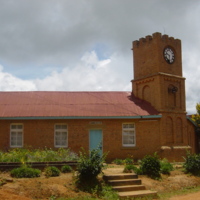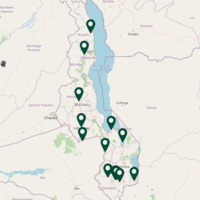Richard Thornton grave
Description:
Richard Thornton was born on the 5 April 1838 in Yorkshire, England. He attended grammar school in Bradford before entering the Royal School of Mines, London, in October 1855. After 2 years he passed his examination with great distinction and won a Government prize and the De la Beche Medal for excellence in geological studies. He joined Dr. Livingstone's expedition in 1862. Nine months later, on the 21 April 1863, Thornton died on board the boat 'Pioneer' in the upper reaches of the Shire River. He was 25 years old.
Mwalawolemba Rock Paintings
Description:
Rock Paintings on Mikolongwe Hill. The site consists of red and white rock paintings which were mostly done by finger. The paintings have animal figures in white; and footprints, circles and sun-rays in red . The red paintings are much older than the white ones, dating to as early as the Iron age. The meanings of what was written vary from female initiation rites to a calendar pattern which depicts change of seasons.
Fort Lister
Description:
1893-1902. Well preserved ruins on top of the pass between Mulanje and Mchesi mountains. The Fort was built to counter slave trade activities by some Yao chiefs in the Shire highlands who used the pass as a route to the Indian Ocean. It is on top of the pass between Mulanje and Mountain and Michesi Hill. It was an important Slave Trade Route used by Yao chiefs among whom were Mkanda, Matipwiri, Nyezerera and Kawinga. The Fort was built by Sir Harry Johnston in 1895 and named after Sir Harry Vilkers Lister of the Foreign Office. The environmental setting remains the same as it has been the time the forts were built, the same brachystegia trees remains within the property, no human encroachment has occurred.
Blantyre Old Boma
Description:
Built by John Buchanan from 1887 and completed in 1892 the building was the original town hall. in 1891 Sir Harry Johnston turned it into an office hence it became the first British colonial administration centre in Malawi. It entails the history of establishment of colonial rule in Malawi. The location was originally occupied by Ntaja's Stockade, from whom Johnston bought the land. Built in 1892 by John Buchanan, who introduced coffee growing to Malawi. Currently occupied by various tenants. Condition sound, with interesting historic finishes still around building, well, old brick making machine.
Queen Victoria Memorial Hall
Description:
It was built in 1903 as an entertainment centre for the white population. Named Queen Victoria in memory of the Queen whose long reign had then just ended. Served as a Library, Cinema, and a Free Masons temple. In 1933 it became the Town Hall housing the first Blantyre Civic Offices until July 1986, when they were moved to a new building.
St Michael’s & All Angels Church
Description:
This Church was designed by Rev. David Clement Scott, a Church of Scotland missionary who had no formal training in architecture or construction. Its brick composition has remained structurally sound for over a century. Historically, the mission station of which it forms the centre marked the beginning of Blantyre city. The "Mission station" included Church, Offices, School, Botanical gardens and Industrial workshops much of which is still extant today. It is the first site of secondary and technical education in the country. It is important in the history of spreading Christianity in Southern Malawi and in the memory of early missionaries especially Dr. David Livingstone who apart from bringing Christianity, also brought civilisation and legitimate trade to this part of Africa.
March 3 House
Description:
First house to be used by Dr. Hastings Kamuzu Banda (first President of Malawi) in 1958.It was used as his office in the fight against Federation of Rhodesia and Nyasaland (present Malawi).The house was named after a State of Emergence which occurred on 3 march 1959 where Dr Banda was arrested. During the State of Emergency, Malawians stood up against their colonial masters to resist the federation of Rhodesia and Nyasaland; and to oppose arrest of Dr. Banda and other native leaders. Over 60 people were shot dead but the events led to the country getting its Independence in 1966.
Mandala Manager’s House and Compound
Description:
Completed in 1882 as the residence of the African Lakes Company Limited's manager. The oldest existing building in the country. The Company was founded in 1878 by two Scottish brothers, John and Frederick Moir. John Moir was nicknamed Mandala (eye glasses) because he used to wear spectacles and Frederick was nicknamed Kandodo (Walking Stick) because he used to walk with a walking stick. The Manager's house was used as a trading centre from which porters carried goods for distribution to various Mandala stores It was also used as a resting place, a base for settlers and the first commercial bank in central Africa. From here the ALC launched their war on the Swahili-Arab slave traders in Karonga in the 1880s. The Mandala House today is owned by CFAO and is home to the Society of Malawi library and an excellent cafe.
Independence Arch
Description:
It was constructed to commemorate and symbolise the bitter struggle that Malawians underwent in fight against Federation of Rhodesia and Nyasaland. It represents the sheer determination of the people. It was opened on 3rd July 1964 by H. E. Dr. Hastings Kamuzu, the founder of the Nation.
Zomba War Memorial
Description:
Clock tower erected in memory of the men of the KAR (King's African Rifles) who died during both the First World War (1914-1918) and the Second World War (1939-1945).
Queen Victoria and Viphya Memorial Tower
Description:
The clock tower was built in memory of Queen Victoria had ruled Great Britain and Ireland from 20 June 1837 until her death on January 22, 1901 at age 81. The Viphya Memorial was erected in memory of 145 passengers and crew who died when a passenger ship called Viphya sank on 30 July 1946.
Mwala wa Mphini
Description:
The name Mwala wa Mphini in literal translation means "Rock marked with traditional scars" Its geomorphic formation presents a picture of scars that amaze locals and visitors. It dates back to the iron age. Many myths are told about the rock's origin and healing powers. Many believe it to be a sacred rock; local medicine men make healing and protective concoctions from aggregates of the rock.
Memorial to Chief Gomani Chikuse I
Description:
It was constructed in 1927 by the Ngoni tribe of Ntcheu in memory of their patriarch king and one of the greatest pre-colonial rulers of Malawi, Chief Gomani Chikuse I. When the British arrived in Ntcheu, they found him already a ruler over his people. He had many disagreements against the colonial governance. He was shot dead on 27th October, 1896 by a colonial administrator called Captain Ashton over managerial differences. After he was shot, his people constructed a Tomb at the place where he was buried (somewhere between Dombole and Chiole) as an indication of growing consciousness of colonial oppression. 1km NE of Ntcheu Boma.
Chentcherere Archaeological Site
Description:
At this site archeological excavations were conducted and skeletal remains of the small framed Akafula/ Batwa people were found. The findings proved the assertion that red rock paintings found at Chencherere rock shelter were indeed authored by them.
War Memorial, Lilongwe
Description:
Commemorates soldiers who died during the First and Second World Wars; Malawian soldiers who died during different military operations both within and outside Malawi and Malawians martyred during the Independence struggle.
Mtunthama Monument area: Kachere Tree, Drum Tree and Chiwengo
Description:
The place where Malawi's first President, Dr. Hastings Kamuzu Banda received his first formal lessons. The monuments area comprises the Kachere tree which was used as a classroom, the drum tree where a drum which was used to call students hang, and Kamwala Well which was used as a source of water for the school. This site portrays the sheer determination and hunger for education that the masses had; despite difficult learning conditions such as learning from under a tree.
Ekwendeni C.C.A.P. Church
Description:
It was built in 1889 by Dr. Walter Elmslie as an out station but later, a bigger church was built in 1894. It was located within a Ngoni tribal heart land. The Ngonis were notorious for fighting and conquering other tribes, therefore, the coming in of the missionaries facilitated end of conflict between Ngonis and Tumbuka tribes of the area. Life standards also changed for the better as schools, health services and general welfare of the people improved. Civilization came in the area and wars among tribes minimized.
Livingstonia Mission at Kondowe
Description:
In 1894 the Livingstonia Mission moved up the escarpment from Bandawe. Monuments include Church, cairn, Post office, Clock Tower and Stone House (manse). Built in 1894 by Dr Robert Laws. It became the headquarters of the mission. It was named in honour of Dr .David Livingstone, one of early explorers and anti slavery activists. The site was also an early centre of Secondary and Technical education that also relates to promotion of health. It provides a visual historical evidence on the history of education and the spreading of Christianity. Schools belonging to this mission produced some of great minds of Africa i.e., Dr. Hastings Kamuzu Banda and Dr. Kenneth Kaunda the first presidents of Malawi and Zambia respectively.
Gazeeted Monuments
Description:
Gazeeted Monuments map.
Title: Monkey Bay Shipyard Photosphere 1
Description:











